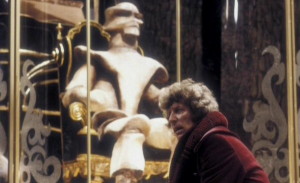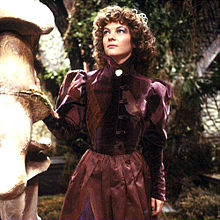 Emerging back into normal space (after escaping E-space at the end of the last story), the Doctor and Adric find the TARDIS passing near a region called Metulla Orionsis, location of the Union of Traken, known to be the most harmonious civilization in the universe. It’s an entire empire, the Doctor explains, held together “simply by people being terribly nice to each other.” It’s governed by the Keeper of Traken, who has near godlike powers through being able to draw on the combined psychic energy of the harmonious Traken people using a device called “the Source.” With his powers, the Keeper boards the TARDIS to ask for the Doctor’s help.
Emerging back into normal space (after escaping E-space at the end of the last story), the Doctor and Adric find the TARDIS passing near a region called Metulla Orionsis, location of the Union of Traken, known to be the most harmonious civilization in the universe. It’s an entire empire, the Doctor explains, held together “simply by people being terribly nice to each other.” It’s governed by the Keeper of Traken, who has near godlike powers through being able to draw on the combined psychic energy of the harmonious Traken people using a device called “the Source.” With his powers, the Keeper boards the TARDIS to ask for the Doctor’s help.
It’s said that the air of Traken is so saturated with goodness that evil simply dries up and withers away, and the Keeper explains this is more than mere legend: aliens of evil intent, if they land on Traken, are turned to stone on the spot. The Traken people call these petrified creatures “melkur” and, being so nice, care for them kindly until they finally crumble into dust. But the latest Melkur to arrive on Traken has been hanging on for an unusually long time. Meanwhile the Keeper himself is nearing the end of his thousand-year life, and during such a period of transition the harmony of Traken always begins to break down as his control over the Source weakens. We soon learn the Melkur is taking advantage of this time of weakness, whispering in the ears of vulnerable Trakenites and sowing the seeds of ever-greater trouble. It seems there’s a serpent in the garden. (But isn’t there always?)
BBC TV shows in this era were performed and staged mostly like theatrical plays, a style dictated by the size of the video cameras of the time (in combination with the budgetary requirement to shoot on video rather than film while in-studio). The Keeper of Traken, though, is in a “stage-like” class of its own. The Traken characters pose themselves as if facing the theater and declaim their lines to make sure they’re heard in the back row. This was entirely deliberate: as the script went through various drafts, with different “styles” considered for Traken culture, it was eventually decided that the best fit was to make it all seem quasi-Shakespearian. The dialog, costumes and sets were all designed to suggest an Elizabethan stage play, without ever directly borrowing. And it actually works: the formal/theatrical air gives a texture to the idea of a society founded entirely on courtesy and kindness, which otherwise we wouldn’t be able to see since we only encounter that society at a time when those things have broken down.
At the same time, there’s a disquieting undercurrent to the whole idea. As the story progresses, it becomes clear that Traken’s harmony is not an entirely voluntary phenomenon— the first clue is the way it break down when the Keeper weakens near the end of his life. It’s actually the Source that allows the Keeper to, at least to some degree, control the minds and actions of people on Traken. Melkur’s plan, of course, is to seize that power for himself. Doctor Who last visited this territory way back in its first season with The Keys of Marinus. There, we also had a “justice machine” capable of preventing evil thoughts in the population, and a villain determined to take it for himself, but the story ended with the Doctor and company gladly seeing the machine destroyed, and the lesson was “Justice through mind control is not worth the price.” Here, by contrast, the Doctor is happy to beat the bad guy and restore the Trakenite status quo.
In fairness, the previous Keeper is clearly shown never to have used his power for such outright control of his subjects. When Melkur gains control of the source, the Doctor’s chief ally in the story, Consul Tremas, is shocked to discover that Melkur can control him. And since the Keeper normally names his own successor, and has access to all the minds in Traken, presumably he’s able to pick someone who also would not abuse his power (in fact, writer Johnny Byrne says the original impulse for the story was to look at the importance of choosing the right person for any position of extreme power). Even so, it’s a tad jarring. You’d expect a near-anarchist like the Doctor to oppose such a system even if he encountered it while it was working properly (he probably wouldn’t actually do anything about it without a villainous threat to provide the pretext, but he sure wouldn’t like it). This time, though, he actually goes out of his way, after beating the bad guy, to help the Trakenites “keep this charming little custom going.”
But all this is the kind of thing you think of when mulling over the story after it’s done. The story itself is entertaining, moves at a nice pace, and has the added bonus of a very important twist— which I’ll put in the details: spoiler warning before reading on!
Details
- [Seriously, stop reading right now if you want to watch the story without spoilers]
- This episode introduces a new companion for the Doctor: Nyssa, the teenage daughter of Consul Tremas. It’s not apparent in this story that she’ll become a companion, as there’s no move for her to join the TARDIS crew and she stays on Traken at the end. But plot threads from this story carry over to the next, and Nyssa will reappear and join the crew.

- The episode provides a twist (albeit a heavily foreshadowed one) late in the fourth episode, when it is revealed that the “Melkur” is actually a TARDIS disguised as a petrified creature, and the real villain is the Doctor’s old enemy, the Master. Last seen as a withered near-skeleton in The Deadly Assassin, where the idea of the 12-regeneration limit for Time Lords was introduced to explain his condition, the Master is still in that state (albeit with far less horrific makeup on the actor this time, since the Hinchcliffe/Holmes Gothic horror era is over) and hopes to use the powers of the Keeper to transfer his consciousness into the Doctor’s body— and also to use his control over the Trakenites to turn them into a galaxy-conquering army. Although thwarted in both ambitions, he manages to survive, and in a shocking last-minute turn takes over the body of Tremas, who has been the Doctor’s ally through the story. It’s an unexpected dark turn right at the end, after the Doctor has departed with the usual everything’s-good-now farewell.
- Anthony Ainley, who plays Tremas in this story, will play the Master for the remainder of the Classic series. I’ll say more about his portrayal next week, when he appears as the Master rather than as a Consul with an unfortunate anagram name.
- John Nathan-Turner had decided to reintroduce the Master as Tom Baker left the series at the end of season 18, feeling that a struggle against his arch-enemy would be a proper sendoff for the longest-serving, and most popular, actor to play the Doctor. He decided to set up the Master’s return in this episode. The original script for Keeper of Traken did not include the Master— Melkur was just Melkur. The final twist, and the earlier foreshadowings of it throughout the story, were added in a last-minute rewrite.
- As I mentioned in an earlier post, John Nathan-Turner didn’t have a creative background prior to becoming Dr Who’s producer, he was promoted from Production Unit Manager, a job on the business side of TV production. As a result, he tended to let his various script editors over the years take most of the role that today is called the “showrunner.” But, as season 18 script editor Christopher Bidmead notes in an interview on the DVD for this episode, he did have some very strong ideas which he would insist upon, though they seemed to come out of the blue. Sometimes they’d work, sometimes they wouldn’t. Bringing back the Master was an idea that worked— I think it makes Keeper better than it would have been otherwise— although I have some caveats about the design of the character which I’ll save for next week.
- On the other hand, it was also JNT’s idea to have the doomed Consul given a name that is an anagram of “Master.” Going forward, keep an eye out for characters with anagram names who turn out to be the Master, but as Bidmead points out, in this case it makes no sense, as Tremas is not a disguise but rather someone with no connection to the Master until the Master takes his body.
- And I haven’t mentioned the question marks yet. I should have back at the start of season 18, but now I’ll save it until the start of next season.
Next Week:
“Logopolis” 4 episodes, the season 18 finale, and the end of an era.

